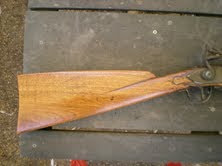This clothing and equipment list is based on a civilian lifestyle with the men having to occasionally attend militia musters and scouts. Women may also participate in Historical Trekking but if attending militia scouts they are required to dress in part or wholly in men’s clothing.
This list is a guide only, and you will need to do your own research to help you in your personal choices of clothing types and colours and the equipment and tools you wish to use and carry.
Civilian men’s clothing.
• Low crowned wool felt hat.
• Linen or cotton shirt.
• Linen or cotton neckcloth/neckerchief.
• Linen/wool/leather breeches.
• Linen or woollen stockings or socks.
• Leather shoes or moccasins.
• Wool or linen weskit/waistcoat.
• Men’s work frock or frock coat.
• Leather leggings and garters (optional).
Civilian woman’s clothing.
• Shift/chemise.
• Linen or woollen stockings.
• Garters.
• Mobcap.
• Straw hat (optional).
• Stays.
• Pockets.
• Panniers (formal wear only).
• Underpetticoat.
• Overpetticoat.
• Kerchief.
• Stomacher (open front clothing).
• Gown.
• Bodice (closed front clothing).
• Cloak.
• Apron.
• Shoes.
Woodsman and woodswoman clothing.
• Low crowned wool felt hat.
• Linen or cotton shirt.
• Linen or cotton neckcloth/neckerchief.
• Linen/wool/leather breeches or breechclout.
• Linen or woollen stockings or socks (optional).
• Linen or wool weskit/waistcoat.
• Men’s work frock or frock coat.
• Leather or woollen Indian style leggings, garters, and waist tie.
• Moccasins.
• Leather waist belt or wool woven sash.
Alternate clothing for women.
Some women like Ann Bailey wore a mixture of men and women’s clothing. The mix is totally your choice.
Other images of men and women’s clothing.
Woodland Indians, white, black and native.
Captives were often adopted into Indian society and as such were considered to be Indian in every respect.
Men’s clothing.
• Linen or cotton shirt.
• Breechclout and waist tie.
• Wool or leather leggings and garters.
• Moccasins.
• Wool woven sash.
• Frock coat or matchcoat or frock or any combination.
Women’s clothing.
• Leather or wool woven waist tie for legging ties.
• Linen or cotton shirt.
• Wool woven sash.
• Wrap around skirt.
• Wool or leather leggings and garters.
• Frock coat or matchcoat.
• Moccasins.
Equipment.
If you have a trade or a craft which you intend to practice then you will need the tools and equipment for that trade or craft. Also there are “toys”, accessories for both men and women such as a pocket watch or a chatelaine with scissors and other accessories.
Men from the age of 16 years to 60 years were expected to join the local militia. About town these men may carry such items as pocket pistols, swords, or a cane if they were wealthy, but if they were the “middling sort”, then they would carry these items only when attending militia musters. For militia musters they would be required to carry:
• "one good Musket, Fuzee or other Firelock, well fixed, a Cutlass, Bayonet or Tomahawk, a Cartouche Box filled with 12 or more Cartridges of Powder, 12 or more sizeable Bullets and 3 Good Flints." 1757.
• "Each soldier to provide himself with a good fire arm, a steel or iron ram rod and a spring for same, a worm, a priming wire and brush, a bayonet fitted to his gun, a scabbard and belt thereof, a cutting sword or tomahawk or hatchet, a cartridge box holding fifteen rounds at least, a hundred buckshot, six flints, one pound of powder, forty leaden balls fitted to the gun, a knapsack and blanket, a canteen or wooden bottle to hold one quart." (Journal of Arthur Harris of the Bridgewater Coy of Militia.)
• I gave orders to them to go home and fetch their arms whether guns, swords, pitchforks, axes or whatsoever might be of use against the enemy and for three days provision in their knapsacks”(early 18th century).
On top of this of course is any personal items that you may wish to carry, such as a snapsack instead of a knapsack, or a clasp knife, shot pouch, powder horn, gun tools, spare lock parts, a leather costrel, a pistol, a cup, small trade kettle, a wooden spoon.
French Militia.
EQUIPMENT FOR THE MILITIAMAN DURING SUMMER:
1 blanket; 1 capot or bougrine; 2 cotton shirts; 1 breech cloth; 1 pair of leggings; 2 skeins of thread; 6 needles; 1 awl; 1 firesteel; 6 gunflints; 1 butcher knife; 1 comb; 1 gunworm; 1 tomahawk; 1 pair moccasins every month.
For The Winter Equipment In Addition To The Summer One: 2 pairs of short stockings; 1 pair of mittens; 1 vest; 2 folding knives;
1/2 aune of blanket to make leggings; 2 pair of deerskin shoes; 1 greased deerskin; 2 portage collars; 1 toboggan; 1 pair of snowshoes; 1 bearskin.
4. AUGMENTATION FOR EVERY SOLDIER AND MILITIAMAN:
1/2 pound (livre) of gunpowder; 1 pound (livre) of balls; 1 pound (livre) of tobacco; 1 axe for 2 men; 1 tarpaulin and 1 cooking boiler for every 4 men
Woodsman and Woodswomen Equipment.
The above French equipment is a good guide for woodsrunners. But again there may be other personal items that you consider necessary when travelling far from home such as a powder wallet or bag for carrying extra gunpowder or storing spare tinder fungus, or a crooked knife used for making anything from a wooden spoon to a canoe or survival bow and arrows. Plus of course your choice of gun and shot pouch, probably an oil cloth for shelter and perhaps an extra butcher knife carried in your pack or tucked inside the top of your leggings. If you look over the militia list you will see other items.
Spectacles need to be of period design, so research these carefully. I decided to use 17th century eye glasses so that I know they will fit into any period early or late 18th century.





.JPG)


.jpg)
.jpg)











.JPG)



























